Hall 12 — the beginning
Spiel '11 report section 2
The other problem is how to organise my report. Well, Spiel takes up several halls at the Messe, so let me start at the main entrance and go round hall by hall. Confronting you as you come in (to hall 12) is the large stand occupied by international distributor Asmodee. They are based in France and their stand is a showcase for several French publishers. Repos is the most obvious-as their guys all wear sombreros-but Ystari is there as well. Their new game, Olympos, is designed by the man who gave us Vinci and Evo, Philippe Keyaerts. It's also one of the games in this year's EuropeMasters tournament, so I'm quite familiar with it.
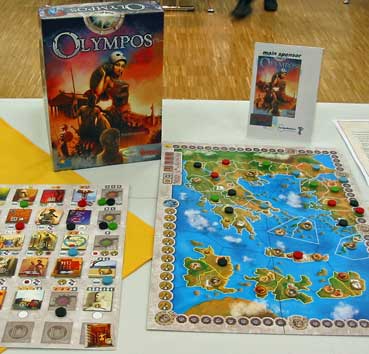 The main board shows Ancient Greece, mainland and islands and extending to areas that represent the mythical Atlantis. Players bring their pieces on at the top (northern) edge of the board and migrate south. The areas they hold provide resources and there can be some squabbling over these. The main use of resources is to buy 'discoveries' and 'wonders' which are laid out on the second board.
Discoveries provide advantages to players (such as military power to give them the advantage in those territorial squabbles) and are worth points at the end. Wonders (there aren't many of them) are just worth points, lots of points.
The main board shows Ancient Greece, mainland and islands and extending to areas that represent the mythical Atlantis. Players bring their pieces on at the top (northern) edge of the board and migrate south. The areas they hold provide resources and there can be some squabbling over these. The main use of resources is to buy 'discoveries' and 'wonders' which are laid out on the second board.
Discoveries provide advantages to players (such as military power to give them the advantage in those territorial squabbles) and are worth points at the end. Wonders (there aren't many of them) are just worth points, lots of points.
Each turn, players will either move a piece on the map board or buy something from the other board. Whatever they do will cost a certain amount of time, which is marked on the track round the outside of the board. The player in last place on this track then gets a turn-take quick actions and you can get several turns in a row. As time progresses, the Gods will interfere, helping or hindering the players. One aspect of the game is thus trying to make sure you get the benefits of this-or at least avoid the penalties. When players reach the end of the track they score up and the player with the most points win. I'm very taken with Olympos and am playing it with my games group. It gets an initial 9/10 on my subjective scale.
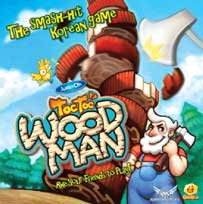 Behind Asmodee I found a company new to me, Mayday Games from the USA. They're best known for their card sleeves, but they were showing several new games. Toc Toc Woodman originates in Korea (designed by Justin Oh and published by Gemblo) and is a fun dexterity game-a kind of reverse-Jenga. The players build up a plastic
tree,
each layer
consisting of a central 'trunk' with four pieces of 'bark' on the outside. Then they use the little plastic axe to try to knock off pieces of bark. You get a point for each piece of bark, but lose points if you knock the trunk off! Knocking the tree down is a complete loss, of course. A trivial game, but one that's great fun-especially after the application of beer. 8/10 on my highly subjective scale and much appreciated by my nephews (without the beer!).
Behind Asmodee I found a company new to me, Mayday Games from the USA. They're best known for their card sleeves, but they were showing several new games. Toc Toc Woodman originates in Korea (designed by Justin Oh and published by Gemblo) and is a fun dexterity game-a kind of reverse-Jenga. The players build up a plastic
tree,
each layer
consisting of a central 'trunk' with four pieces of 'bark' on the outside. Then they use the little plastic axe to try to knock off pieces of bark. You get a point for each piece of bark, but lose points if you knock the trunk off! Knocking the tree down is a complete loss, of course. A trivial game, but one that's great fun-especially after the application of beer. 8/10 on my highly subjective scale and much appreciated by my nephews (without the beer!).
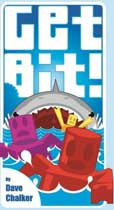 Nearly as silly is Get Bit!, a game of robot-eating sharks designed by Dave Chalker. Yes, robots being eaten by a shark! Each player has a model robot with detachable limbs and a set of cards. The robots are placed in a line with the shark at the back. Players then choose a card secretly. When revealed, players move their robot to the front in card order. Except for those who've played
the same number, who don't move. The robot at the back loses a limb to the shark, Maneater-style.
Once all four limbs have gone, you're out and the player in front when there are only two left wins. Wonderfully silly, it gets 7/10 on my highly subjective scale.
Nearly as silly is Get Bit!, a game of robot-eating sharks designed by Dave Chalker. Yes, robots being eaten by a shark! Each player has a model robot with detachable limbs and a set of cards. The robots are placed in a line with the shark at the back. Players then choose a card secretly. When revealed, players move their robot to the front in card order. Except for those who've played
the same number, who don't move. The robot at the back loses a limb to the shark, Maneater-style.
Once all four limbs have gone, you're out and the player in front when there are only two left wins. Wonderfully silly, it gets 7/10 on my highly subjective scale.
Then we have Eaten by Zombies – or perhaps it should be "The Walking Dead – the card game"? Yes, it's a game of trying to survive in a zombie-infested world. Designed by Max Holliday, this is a Dominion-like game where players each have their own deck of cards. Each turn they play cards from their hand, draw more cards and re-cycle what they've played when their deck runs out. There's also a deck of zombie cards and players must decide whether to fight or flee the current zombie, depending on the cards available to them.
Success means buying useful cards that go into your hand for the next turn, failure means losing cards. However, defeated zombies also go into players' discard piles and gradually turn up in their hands where they can be used to make things worse for the other players! It is possible for the players to win, jointly, by killing off all the zombies. However, the expectation is that the players will gradually succumb, leaving the last man standing as the winner. My problem is that I just don't get the whole zombie thing. Why are they so popular in games, books, films and TV? Eaten by Zombies is a perfectly decent game, but the theme has no appeal for me and I don't care for knock-out games, so it just gets 5/10 on my highly subjective scale.
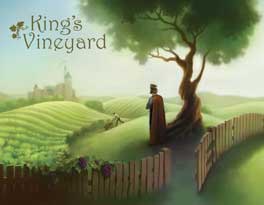 This leaves King's Vineyard, designed by David Haslam and Sandeep Kharkar. While this comes in a decent-sized box, it's essentially a card game using two different sizes of card. Players plant the large grapevine cards from their hands, subject to certain restrictions. Each turn these then grow, using the smaller vine cards, until the grapes ripen and the
vine starts
to wither. Players must harvest their grapes to be able to plant more, but they also want ripe grapes still
on the vine to score points.
This leaves King's Vineyard, designed by David Haslam and Sandeep Kharkar. While this comes in a decent-sized box, it's essentially a card game using two different sizes of card. Players plant the large grapevine cards from their hands, subject to certain restrictions. Each turn these then grow, using the smaller vine cards, until the grapes ripen and the
vine starts
to wither. Players must harvest their grapes to be able to plant more, but they also want ripe grapes still
on the vine to score points.
Several 'King' cards are shuffled into the deck of grape cards and trigger a scoring when drawn (the King inspects his vineyards). Players score points for their ripe grapes in various different ways. So the trick to the game is getting your timing right: you want lots of grapes that ripen just before a King card is drawn. The stuff you've already planted, ripened and harvested just gets in the way. A neat mechanism that makes this rather more than the straightforward game it initially appears to be. Okay, it's a lightweight, but it has enough appeal that I give it an initial 7/10 on my highly subjective scale.
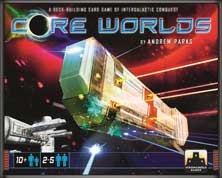 A couple of aisles across was another US publisher, Stronghold Games, who caught my attention last year with a new edition of Escape from Atlantis. The company aims to re-publish older classics alongside new games and this year's classics are Crude: the Oil Game (better known – to me at least – as McMulti) and Outpost. The new games include Core
Worlds, one of the games I did get to play at the show, designed by Andrew Parks.
This is a Dominion-style card game of galactic domination, with the winner being the player with the highest value of conquered worlds at the end of the game's ten turns.
A couple of aisles across was another US publisher, Stronghold Games, who caught my attention last year with a new edition of Escape from Atlantis. The company aims to re-publish older classics alongside new games and this year's classics are Crude: the Oil Game (better known – to me at least – as McMulti) and Outpost. The new games include Core
Worlds, one of the games I did get to play at the show, designed by Andrew Parks.
This is a Dominion-style card game of galactic domination, with the winner being the player with the highest value of conquered worlds at the end of the game's ten turns.
Each turn, cards are laid out: tactics and equipment for players to draft and planets for them to conquer. Players can draft a card (into their discard pile), use a card (from hand), deploy military units (from hand) or use deployed forces to take a planet: one action at a time. Whatever they do will cost energy and action points and a player's turn is over when they run out of either (though they can pick up extra energy during their turn).
In the last couple of turns, the cards available provide bonuses for holding certain things (lots of spaceships, for example). These provide some goals for players to build towards during the game-and to watch out for what the others are up to. Apart from this, there's no interaction between players, so the game is very much about building up your own empire. It should be my sort of game, but I was distinctly underwhelmed on playing it for the first time. I definitely want to try it again and it gets 7/10 for the time being on my highly subjective scale.
Moving through the hall, there's a row of smaller companies along the wall between the halls. One of these is Cwali, the imprint of Dutch designer Corné van Moorsel, who had several new games on show. I will skip past Champions 2020 as it's a two-player football (soccer) game. Ab in die Tonne (In the Bin) looks like good fun, though. Each player has a laminated board propped up to make a slide. They also have a set of objects, laminated cardboard shapes, to go into their bin.
The first player chooses an object, the others must follow suit and they all let it slide down their ramp. Then it's the next player's turn to choose. Once everything's been put in the bin, players get penalty points depending on how high up their slide the objects come. Brilliant! There are a few twists, so you play the game three times with different scoring options. This is one I really want to play with my nephews and it gets 7/10 for the time being.
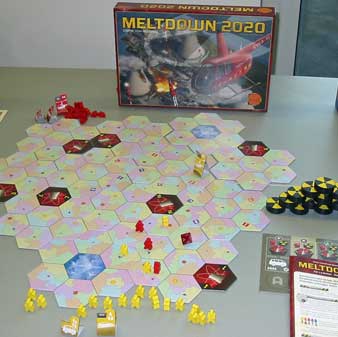 The game I really liked the look of was Meltdown 2020. Well, I say that, but the pastel colouring of the 'board' does look rather odd. It's actually made up of a number of boards, divided into hexagonal areas, that fit together to give different layouts. They show seven nuclear reactors, two airfields and the starting positions of players' pawns. The players also
have a set of three vehicles, each of which is made of a thick cardboard strip that folds up and interlocks
to make a neat playing piece. I think Corné's missed a trick here: given the current popularity of 3-D, he could have billed this as a 3-D game. :-)
The game I really liked the look of was Meltdown 2020. Well, I say that, but the pastel colouring of the 'board' does look rather odd. It's actually made up of a number of boards, divided into hexagonal areas, that fit together to give different layouts. They show seven nuclear reactors, two airfields and the starting positions of players' pawns. The players also
have a set of three vehicles, each of which is made of a thick cardboard strip that folds up and interlocks
to make a neat playing piece. I think Corné's missed a trick here: given the current popularity of 3-D, he could have billed this as a 3-D game. :-)
The aim of the game is to rescue your pawns as the reactors melt down. A roll of the die causes an increase or decrease in the radiation from one reactor. Then players move a vehicle, collecting and/or dropping off pawns as they go, but subject to the vehicle's movement and capacity limits. Once each type of vehicle has moved, radiation affects the pawns that are close enough to a reactor that's radiating. In another '3-D' touch, they are laid on their side if ill (one dose of radiation) and onto their backs if very ill (two doses).
Pawns moved to an airfield are flown to safety, as vehicles can be, too. The game ends when a reactor goes critical or the board is cleared. Players get a point for each pawn or vehicle saved with their condition being a tie-breaker. It's a neat game, if rather lighter than I was expecting. On my first play, we had some very fortunate die-rolls and nobody lost more than one pawn! I'm sure it's usually tougher than that and I look forward to a stiffer challenge next time round. I'll give it 7/10 on my highly subjective scale for the time being.
Next section: Halls 11 and 10 – the big boys
Previous section: Introduction
